Aquaculture - Acoustic Deterrent Device (ADD) use: parliamentary report
Report to the Scottish Parliament on the use of acoustic deterrent devices by the Scottish aquaculture sector at finfish farms as required by section 15 of the Animals and Wildlife (Penalties, Protection and Powers) (Scotland) Act 2020.
Chapter 3. Extent of acoustic deterrent device use in the aquaculture sector
1. Introduction
The Scottish Government commissioned research in 2019 to improve understanding of the extent and efficacy of ADD use in the aquaculture sector. One objective of the research was to undertake an assessment of the extent of ADDs used at Scottish finfish farm sites. Consequently the information presented in this chapter comes from an analysis of data collected between 2014 and 2019 and winter 2019/20 (as outlined in Coram et al., in prep). However, the way in which farmers use seal management measures, including ADDs, is continually evolving, and there are likely to have been some changes in the use of ADDs across finfish farms since the period of data collection ended. As a result, a supplementary section has been included in this chapter to provide a summary of recent changes in ADD use that has been reported by the industry.
2. Data sources used to provide information on the extent of ADD use
To provide an assessment of ADD use across Scottish finfish farms, information was collated from four main sources: (a) finfish producers; (b) seal licensing database; (c) ADD manufacturers and; (d) RSPCA accreditation scheme. The information collected included: ADD type and usage, mode of operation, number of transducers used, seal depredation rate and use of alternative measures. There was considerable variation in the amount, quality and content of data collected from these sources and often a degree of overlap existed which is explained in more detail in Coram et al. (in prep). To provide wider context in terms of the number of active finfish sites and the days each site was stocked, information was taken from the Scottish Government data portal (Scotland's Aquaculture, 2020). This assessment only considered sites producing finfish in seawater, with shellfish and freshwater farms excluded.
Finfish sites have been categorised into regional groups according to their local authority area (see Figure 3.1) in order to consider the regional distribution of the information included. Finfish sites in the Firth of Clyde around Arran are included in Argyll and Bute.
When interpreting the results below, a distinction is required to be made between ADDs that are deployed at the finfish farm site and those that are actively used (i.e., switched on). For example, it is clear that in some instances, ADDs are deployed but not activated. It should also be noted that the information in this report reflects usage of ADDs at the time of the research; this may not necessarily be the case now as referred to later on in this chapter.
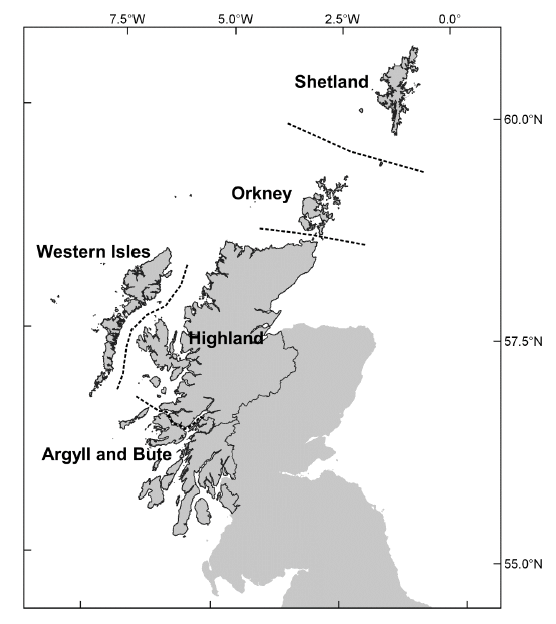
Chart Description
A map of Scotland showing local authority areas and the borders used for regional categorisations of finfish farms. The local authorities shown are Argyll and Bute, Highland, Western Isles, Orkney and Shetland. The map is bordered with longitudinal and latitudinal markings (from 55.0°N to 60.0°N, and 0.0° to 7.5°W).
3. Assessment of ADD use at finfish farms between 2014 and 2019
This section provides an assessment of the extent of ADD use at finfish farms between October 2014 and October 2019. In particular this section focuses on the number and proportion of finfish farms deploying and using ADDs, the types of ADDs used and their spatial and temporal spread.
Extent of ADD deployment and use at finfish farms
From 2014 to 2016 there was an increase in the number of finfish sites that reported deploying ADDs from 119 to 154 sites. After a relatively consistent period between 2016 and 2018, there was a slight decrease in sites which reported deploying ADDs with a total of 146 finfish sites in 2019, representing 68% of the total number (216) of active finfish farm sites across Scotland (Figure 3.2).
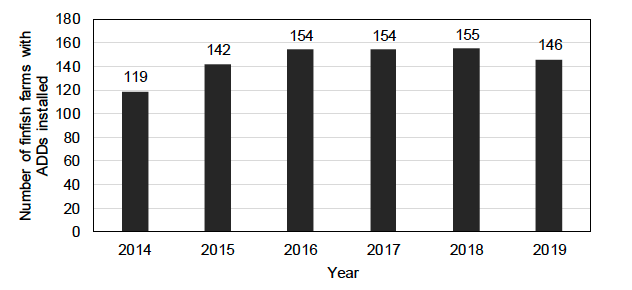
Chart Description
A bar chart showing the number of finfish farms with ADDs deployed from 2014 to 2019. There is an increase from 2014 to 2016, climbing from 119 in 2014, to 142 in 2015, to 154 in 2016. Between 2016 and 2018 the numbers of ADDs deployed remain stable – 154 in 2016, 154 in 2017, and 155 in 2018. In 2019, this number fell to 146.
These changes between 2014 and 2019 are broken down by region in Table 3.1. The highest proportion of finfish sites deploying ADDs has been in the Western Isles and Highland. The proportion of sites with ADDs increased in all regions except Argyll and Bute from 2014 to 2019. In Highland, Shetland, Argyll and Bute, and the Western Isles, there was an increase from 2014 until around 2017. Orkney has the lowest number and proportion of finfish farm sites deploying ADDs, but this increased in 2019. The average totals have varied between 60 to 71 % of all active finfish sites deploying ADD systems.
| Region | 2014 | 2015 | 2016 | 2017 | 2018 | 2019 | ||||||
|---|---|---|---|---|---|---|---|---|---|---|---|---|
| Highland | 41 | 78.8% | 44 | 72.1% | 50 | 82.0% | 51 | 85.0% | 52 | 85.2% | 50 | 82.0% |
| Orkney | 2 | 9.5% | 4 | 17.4% | 4 | 17.4% | 2 | 8.3% | 2 | 8.3% | 8 | 36.4% |
| Shetland | 11 | 21.2% | 18 | 33.3% | 22 | 41.5% | 23 | 48.9% | 24 | 54.5% | 16 | 36.4% |
| Argyll and Bute | 38 | 88.4% | 44 | 84.6% | 44 | 86.3% | 42 | 82.4% | 42 | 84.0% | 37 | 72.5% |
| Western Isles | 27 | 77.1% | 32 | 82.1% | 34 | 85.0% | 35 | 94.6% | 34 | 89.5% | 34 | 91.9% |
| Total | 119 | 58.3% | 142 | 61.7% | 154 | 67.2% | 154 | 70.3% | 155 | 71.1% | 146 | 67.6% |
Of the total number of fish farm sites deploying ADDs, only a proportion of these are reported as being actively used (i.e., switched on) on any particular day (Figure 3.3). Despite fluctuations over time and slight changes in some regions, between 2014 and 2019, the overall total number of finfish farm sites across Scotland with ADDs switched on remained consistently between 80 and 100 (apart from one period in 2016 where numbers dropped below 80). This shows that while approximately two thirds of sites deploy ADDs as a seal management measure not all sites are actively using them at any one point in time.
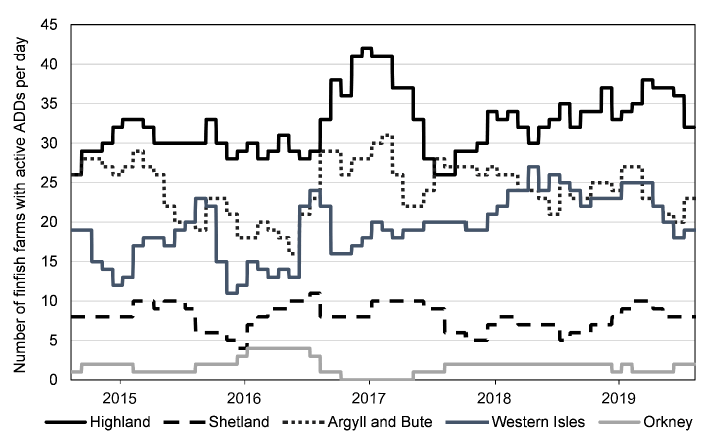
Chart Description
A graph showing finfish farms with active ADDs between 2015 and 2019 per local authority area. There are 12 points for each year – reflecting data taken once per month – split by local authority area. The y axis extends from 0 to 45, and the highest point on the graph is in Highland in January 2017 where 42 finfish farms had active ADDs. The peak for Argyll and Bute was in February 2017 with 31, the Western Isles reached 27 in April 2018. Shetland peaked in July 2016 with 11, and Orkney at 4 from January to July 2016.
However, where sites are actively using ADDs, they are generally switched on for a considerable proportion of the time that the farm is stocked. For example, between 2017 and 2019, when ADDs were used they were reportedly switched on at farms for around 90% of the time (Table 3.2).
| Year | 2014 | 2015 | 2016 | 2017 | 2018 | 2019 |
|---|---|---|---|---|---|---|
| Total | 93% | 88% | 77% | 89% | 89% | 90% |
Number of transducers deployed at finfish farms
As well as changes in the number of finfish farm sites deploying ADDs, between 2014 and 2019 there have also been changes in the number of units (or transducers) deployed, and how many of these have been in active use. Figure 3.4 shows the change over time in the number of transducers on finfish farm sites across Scotland.
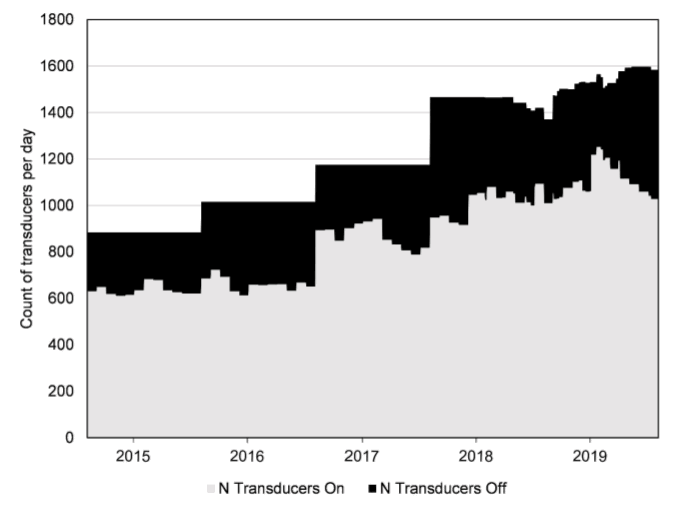
Chart Description
A chart showing the change over time in the number of ADD transducers per day on finfish farm sites across Scotland. This increased from approximately 900 in 2014, peaking at 1600 in mid-2019 before decreasing slightly by the end of the year. The chart shows that approximately two-thirds to four-fifths of these transducers are turned on at any time.
From 2014 to 2016, the number of transducers increases in line with the total number of finfish farms using ADDs, but after 2016, when the number of farms with ADDs peaked and began to decline, the number of transducers continued to increase. The increase continued until the end of 2019, when 1,583 individual transducers were present on farms, although the rate of increase appears to have slowed since 2017.
Since early 2019, a gradual reduction in the proportion of transducers being actively used appears to have occurred, reducing from 72% in February 2019 (1,107 out of 1,532) to 65% (1,027 out of 1,583) in October 2019.
Types of ADDs deployed at finfish farms
The term acoustic deterrent device covers a wide range of device types in terms of frequency, patterns of emission, and different devices are used in different circumstances (e.g. pingers used for minimising bycatch in capture fisheries, to devices used for pre pile driving mitigation). In a comprehensive review of commercially available acoustic devices in UK waters, McGarry et al. (2020) reported that a total of 28 devices were available for marine industries. However, only seven types of ADDs were routinely recorded as being used at finfish farm sites between 2014 and 2019 (Table 3.3). Where records indicate that an ADD is deployed, but do not specify the ADD type, and where this information could not be verified, they have been recorded as 'unknown'. More detailed information on each of these devices can be found on the manufacturers websites.
| Device | Comment |
|---|---|
| Airmar dB Plus II. | These devices are different iterations of the original Airmar dB II Plus, which emit the same signal types but may have small differences in operating features. |
| Gael Force Sea Guard | |
| MohnAqua MAG Seal Deterrent | |
| Ace Aquatec US3 | This includes records of older devices listed as US2 which is also made by Ace Aquatec and which produces the same signal. |
| Ace Aquatec RT1 | A low-frequency device produced by Ace-Aquatec. Manufacturers state that RT1s are set to 1-2 kHz in applications near harbour porpoise (Ace Aquatec, pers. comm. 2020). |
| Terecos | No longer in production but still in use |
| OTAQ | The system operates on two modes. – protect mode or patrol mode. |
Between 2014 to 2019 there was a shift in the main types of ADDs reported as being deployed at finfish farm sites (Figure 3.5). In 2014, the Airmar and MohnAqua systems, both of which emit the same sound signal were the dominant devices deployed. Use of Terecos and Ace Aquatec US3 were also reported but in lower numbers. In contrast, the OTAQ device was the most dominant device in 2018 and 2019 suggesting that it is slowly replacing the Airmar, MohnAqua and Terecos systems which have all shown a gradual decrease over the last five years. GaelForce and Ace Aquatec RTI have also shown increases since 2017. The Lofitech device was not reported as being used at finfish farms.
From these results, it is clear that there is a gradual shift in ADD system choice by the aquaculture sector in recent years. This is likely driven by a range of factors including adaptive seal management approaches and ongoing development of the devices under manufacture.
Figure 3.5. The percentage of finfish farms deploying each type of ADDs each year between 2014 and 2019
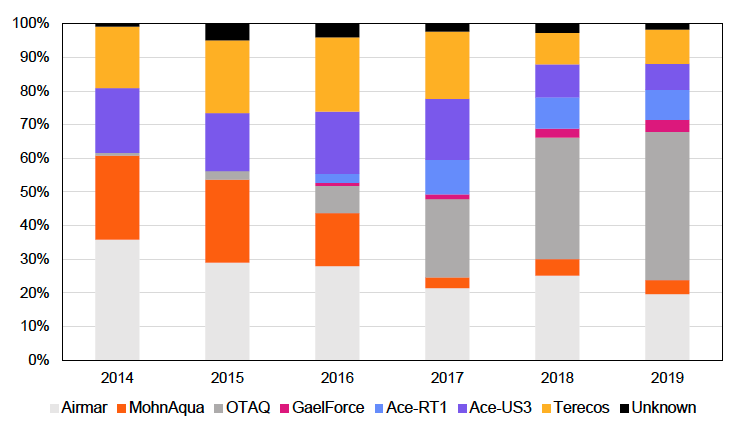
Chart Description
A bar chart showing the type of ADDs deployed by finfish farms each year. The type of ADDs included are: Airmar, MohnAqua, OTAQ, GaelForce, Ace-RT1, Ace-US3 and Terecos. Airmar was most widely used from 2014 to 2016, making up approximately 35%, 29%, and 28% of use respectively. In 2017, spread was close to even between Airmar, OTAQ, Ace-US3 and Terecos, and in 2018 and 2019 OTAQ was most widely used, making up 35% and 42% of total ADD use
Conclusions
The following summarises the conclusions for this section regarding ADD extent between 2014 and 2019:
- The number of sites deploying ADDs increased between 2014 and 2018, peaking at 155 in 2018 which was around 71% of active farms, before decreasing slightly in 2019.
- The total number of farms where ADDs were reported as actively used (i.e., switched on) remained between 80 and 100 for most of the period between 2014 and 2019.
- There was a change in the ADD types reported deployed at sites over time. In 2014 the 'Airmar' type ADDs (Airmar, MohnAqua and latterly GaelForce) were the most widely deployed devices. By 2019 the OTAQ device was the most commonly deployed device.
4. Snapshot of ADD extent at finfish farms (2019/20)
In addition to presenting an assessment of the extent of ADD use at finfish farms between 2014 to 2019, this report also provides a snapshot of ADD extent to reflect the most current timeframe available, drawing onall available data sources as outlined in Coram et al. (in prep) and in section 2 of this chapter. The period covered in this snapshot was October 2019 to April 2020, with information available for 193 finfish farm sites representing 89.4% of the 216 active sites.
Extent of ADD deployment and use at finfish farms
The total number of finfish farm sites which reported deploying ADDs over winter 2019/2020 was 132 sites, representing 68% of sites. In contrast, 61 finfish farms (32%) reported not having an ADD deployed over the same time period. This proportion varied by region (Figure 3.6), with Shetland and Orkney Isles having relatively low numbers of ADDs deployed as a proportion of the number of sites. The highest proportion was found in the Western Isles, with 32 out of 35 sites (91%) reported deploying ADDs.
In additional to regional differences in the deployment of ADDs, there are also significant regional differences in the type of ADDs being deployed at finfish farms across Scotland. Figure 3.7 shows the regional distribution of ADD type deployed at sites in 2019/2020.
Airmar, GaelForce and MohnAqua devices are distributed across all regions, with the largest proportions of farms with these devices in Shetland, Orkney and Highland regions. OTAQ equipment in contrast is not generally deployed in the Northern Isles, but makes up the largest proportion of finfish farm sites in the Western Isles, Highland and Argyll and Bute. The largest proportion of ADDs in the Northern Isles is the Ace-Aquatec RT1.
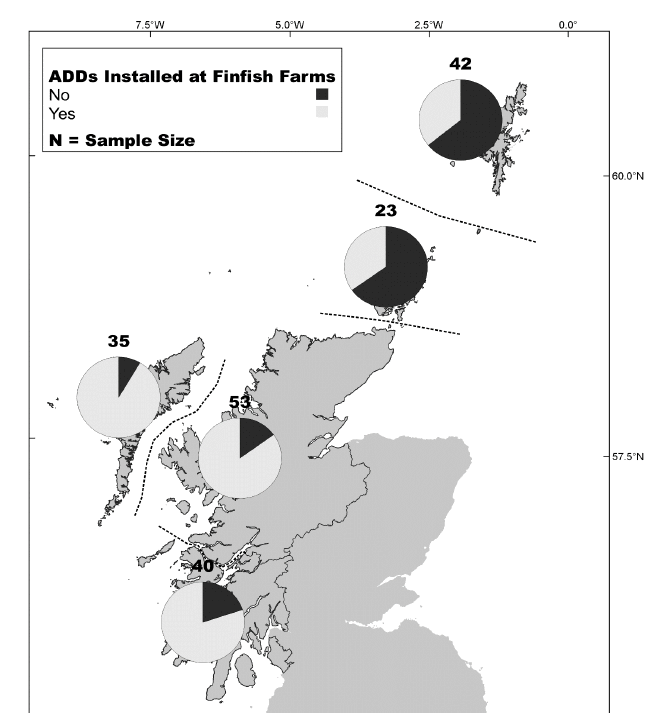
Chart Description
The map of Scotland shown in figure 3.1 is repeated with the addition to this figure of pie charts showing the percentage of finfish farms per local authority area with ADDs installed in winter 2019/2020. In Shetland and Orkney, one third of sampled finfish farms had ADDs installed. This rises to just over three-quarters of surveyed farm sites in Argyll and Bute, four-fifths of sites in Highland, and nine-tenths of sites in the Western Isles.
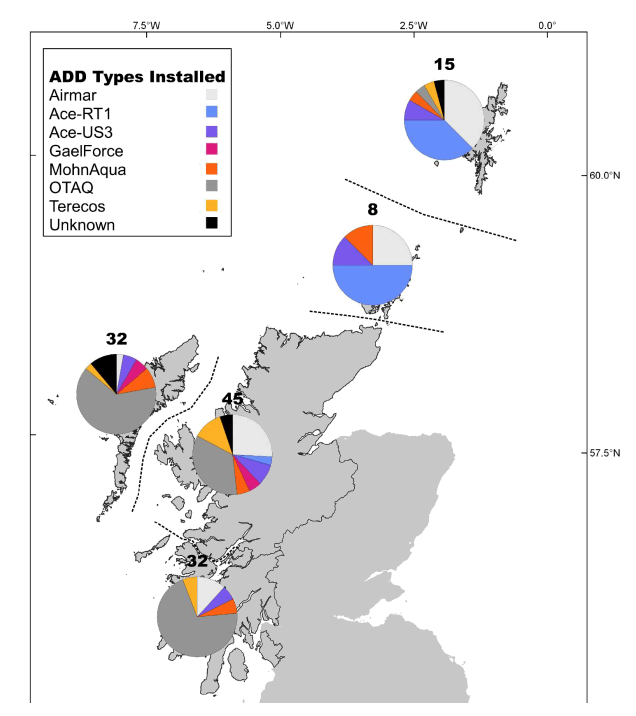
Chart Description
The map of Scotland shown in figure 3.1 is repeated, this figure shows which ADDs are most commonly installed across sampled finfish farms in winter 2019/2020 by local authority. In Shetland, Airmar and Ace-RT1 have similar levels of usage. In Orkney, Ace-RT1 makes up 50% of installed ADDs at surveyed sites. In the Western Isles, Highland, and Argyll and Bute, OTAQ is the most commonly installed ADD – with use at ranging from a third of surveyed sites in Highland, to just under three quarters of sites in Argyll and Bute and the Western Isles.
Conclusions
A snapshot of ADD extent in winter 2019/2020 reported that:
- ADDs were deployed at 68% of Scottish finfish farms, with significant regional variation.
- Highest levels of ADD deployment were recorded in the Western Isles, where 91% of farms reported deploying ADDs. Lowest levels were recorded in Orkney and Shetland with 35% and 36% of farms deploying ADDs respectively.
- The most commonly deployed ADD type during this time was the OTAQ, which was deployed at 31% of active farms. While this varied between regions, the OTAQ device was prevalent in deployment across farms in Argyll and Bute and in the Western Isles. In the Northern Isles the Ace-Aquatec RT1 and the Airmar devices were most commonly reported.
5. Changing position in ADD use
The way finfish famers use seal management measures, including ADDs, is a continually evolving process. During 2020/21 the industry reported a reduction in the overall number of ADDs in operation across all farming regions. Where used, the industry states that ADDs are operated within an adaptive management framework, typically switched on reactively in response to a specific seal predation risk, rather than being continually turned on. Such management frameworks also incorporate a range of approaches that seek to further minimise the amount of sound entering the marine environment, with the use of "soft start" technology (where the sound generated by the ADD increases slowly rather than abruptly), synchronised duty cycles to reduce overall sound propagation, and triggered devices (systems being manually controlled in response to the presence or absence of seals). In addition, the sector also report an increase in the use of low frequency devices (pers. Comm, Scottish Salmon Producers Organisation).
Some of these management strategies are already seen in the results from the data sources collected between 2014 and 2020 and are highlighted in sections 3 and 4 of this chapter.
6. Summary and conclusions
This chapter has provided information on the extent of ADD use at Scottish finfish farms from a range of data sources over a specific time series. Below is a summary of the main findings:
- There is no single, comprehensive source of information on the nature and extent of ADD deployment and use at finfish farms in Scotland. Through research undertaken by Coram et al. (in prep), a collated dataset covering the period 2014 to 2020 was produced, combining information on ADDs from a variety of discrete data sources, to provide an assessment of patterns in ADD deployment and use over time and between regions, and provide the best possible description of recent industry practices. The dataset was collated from a variety of sources, none of which were complete, verifiable or systematic. Therefore it has proven very difficult to determine the actual level of ADD use across the sector and the results should be interpreted with a degree of caution.
- The most recent information available was examined to indicate levels of recent ADD deployment and use (winter 2019/2020), including regional differences, while data on historic use (2014 to 2019) was examined to determine changes in use over time. The extent to which different ADD devices were used and how this varied between regions and over time was also examined.
- During 2020/21 the industry has reported further changes to their use of ADDs which is an evolving and highly dynamic situation.
In light of the information presented in this section, the Scottish Government will work with the sector and regulators to establish a more systematic process for gathering information on ADDs where they are used at Scottish finfish farms. Gathering such information would allow for a greater understanding of the distribution of ADD noise sources, thereby allowing an assessment of trends in usage as well as understanding of the potential for disturbance impacts on marine mammals. Such an approach would be consistent with monitoring of other noise sources in the marine environment where information is gathered for licenced activities.
Contact
Email: Marine_Conservation@gov.scot
There is a problem
Thanks for your feedback